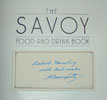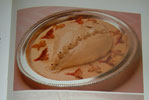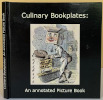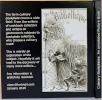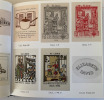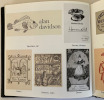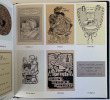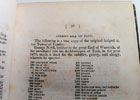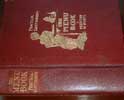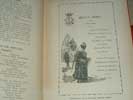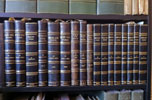Scappi.
Bartolomeo
- Excedingly rare first edition, 1st issue. A Renaissance classic with stunning plates.
OPERA DI M. BARTOLOMEO SCAPPI
CVOCO SECRETO DI PAPA PIO QVINTO, DIVISA IN SEI LIBRI. Nel primo si contiene il ragionamento chef a l’ Autore con Gio.suo discepolo. Nel secondo si tratta di diverse viviande di carne, si di quadrupedi, come di volatili. Nel terzo si parla Flatura, e Flagione de pesci. Nel quarto si mostrano le liste del presentar le vivande in tavolo, cosi di grasso come di magro. Nel quinto si
contiene l’ordine di far diverse forti paste, & altri lavor. Nel sefto, & altimo libro si ragiona de’convalescenti, & molte altre sorti di vivande per gli infermi. Con le discorso funerale che fu fatto nelle effequie di Papa Paulo 111. Con le figure chef anno bisogno nella cucina, & alli Reuerendissimi nel Conclave. [A square Tramezino printer's device showing a picture of Sibylla with large lettering around it]. QVAL PIV FERMO E IL MIO FOGLIO E IL MIO PRESAGGIO. Col priuilegio del summo Pontefice Papa Pio V. & dell’Illustrifs. Senato Veneto per anni XX.
FIRST EDITION – FIRST ISSUE. n/d 1570. Inside board and fep with marbled paper. +1fep. Title Page. [1] 2p PIVS PAPA V. 1p 1570.22.Martij in Rog. 1p Cosmos Medices. 2p ALL’ILLVESTRE, ET MOLTO REVER. SIG. 1p A I LETTORI. [2] Frontispiece Illustrated portrait of Scappi. 1-12(1) RAGIONAMENTO CHE L’AVTORE. 13(1)TAVOLA DEL PROMO LIBRO. 14-369 leaves, as unusually the recto and verso of each leaf count as one page.(1). (This also includes a section of curious pagination between a second page, numbered 123 and titled Libro Quatro Delle Liste, to page 141. There is a first correct page 123 before the mis-pagination. This anomaly is present in other 1st editions, with correct foliation, and no text loss).
6p TAVOLA. 8p HAVENDO. 27 Engraved Plates (one double page) [1] 1 fep. Inside board and end paper with marbled paper. Bound nicely in a full dark brown sheepskin. Spine with two tone black raised bands and dark brown compartments all with fine blind tooling, and a dark red label with text in gilt. The finely blind tooled dark brown boards are two tone, with black centre compartments and with finely tooled edges. The title page and the illustrated plates are very slightly age browned. The whole text-block in very good condition with edges coloured green. In excellent overall condition.
-
The best known earliest printed Renaissance cookery books start in 1475 with Bartolomeo Sacchi's - Platina, De Honesta Voluptate et Valetudine. Next came the oldest cookery text, believed to have been compiled in the late 4th or early 5th century AD and called Apicius - De re Coquinaria, and first printed in January 1498. Followed by Cristoforo di Messisbugo's - Di Bhanchetti, which was published posthumously in 1549. This first edition of Scappi’s Opera, (meaning Work) was printed 21 years later in 1570 and memorably eulogised by Anne Willan - “Bartolomeo Scappi is to cooking as Michelangelo is to fine arts; in its beauty as a printed work, in its ordered presentation and comprehensiveness, his cookbook ‘Opera’ exemplifies the practical elegance of the High Renaissance.” - As Willan alludes to, no other book has matched ‘Opera’ for its twenty seven handsome and scrupulously accurate drawings, depicting the ideal renaissance kitchen setup with all the equipment of the expert cook. This is the first issue of two editions of 1570, undated and with 369 pages rather than the 444 numbered leaves of the dated second issue. Harvard Catalogue gives the first issue priority. Due to differences between settings, there is a suggestion the undated issue may have been printed by Maurice Tramezino’s brother Francesco, in Rome. This bears out because Scappi was in service in Rome and the plates and some initials were made and transferred from Venice and then back for Maurice’s dated edition which was also set from manuscript. It was Pope Pius V who personally gave the Tramezino brothers the privilege on March 29th 1570 to print Scappi’s book. Reprints of ‘Opera’ were continually published up to 1643.
Bartolomeo Scappi, born c.1500 whose origins have been discovered due to fairly recent research, came from the town of Dumenza in Lombardy, with an inscription on a stone plaque inside the church of Luino. Prior to this, the first known fact of his life was in April 1536, when he cooked a dinner afforded by Cardinal Lorenzo Campeggio for the Holy Roman Emperor Charles V. Already Scappi at thirty six years old is serving exalted guests. He served as a cook to several other cardinals after that, and then started to serve Pope Pius IV in the Vatican papal kitchen. He continued work in the service of Pope Pius V as his ‘cuoco secreto’ – private cook. Pius V himself, described Scappi as ‘peritissimus Magister’ (a most skilled Master). Indeed he was. Great thanks must be conveyed to Terence Scully who wrote and published in 2008, a fantastic full English translation of ‘Opera’. To read Sculley’s book is to see how Scappi was indeed an incomparable Master cook. Opera is laid out with astonishing practicality, detail and precision that is not, arguably bettered nor equaled, until Escoffier’s ‘Guide Culinaire’ of 1903. Pope Pius instructed Scappi to teach his two able apprentices, Francisco Reinoso and Giovanni, everything he knew and to also write a book so all his secrets would be preserved. Reinoso was trained as a Steward and Giovanni in the kitchen with Scappi. Pope Pius's instructions to Scappi to undertake the trainings and record his knowledge on manuscript were taken up by him with sincere enthusiasm and diligence. Sculley's English translation acknowledges this and also clearly conveys that two prime ingredients that cannot be divorced from great cooking or a Master Cook; great passion and love. Scappi's Opera achieves its greatness because of that. The Opera comprises 6 books that clarify precisely everything the two apprentices needed to emulate the Master. Bartolomeo lists approximately 1000 recipes of the Renaissance cuisine and describes cooking techniques and tools, giving the first known picture of a fork. He declared Parmesan to be the best cheese on earth and noted that the liver of domestic goose raised by the Jews is of extreme size and weighs between two and three pounds, indicating that Jews of the time were practising the overfeeding of ducks and geese needed to produce Foie Gras. Recipe #140 of book 2 gives long, very detailed instructions for spit-roasting domestic Peacock. He also advises at the beginning of the recipe, that the White Peacocks have black flesh, but are more tasty than than all other fowl. It is treated using the same modern procedure for some game birds, being hung in this case, for eight days before plucking and drawing. Scappi thought that Caviar was better cooked. It came in sealed casks from Alexandria. He also serves it raw on warm toast with orange juice and pepper over it. In Book 3 there are recipes for Hermit Crabs. He informs us that there is not much meat in the claws, but the goodness lies in their viscera. It takes six crabs to fill one shell. Interestingly there were also soft-shell crabs, or as described in Opera; tender crabs, available only from early April to end of May. (These are the same as the famous seasonal soft-shell crabs, harvested on the eastern seaboard of the USA). There are also precise instructions for preparing and cooking Porcupine and baby Hedgehogs. Included are 230 recipes for pastry as well as for pizza and pasta; tortellini, tagliatelli, ravioli etc. All the recipes are very detailed, and the advice on how to keep all ingredients in their best state is exemplary. The qualities, personal and professional, needed to fulfill all positions in the household are comprehensively noted. There are even illustrations and instructions for the kitchen and the food service while the Cardinals are in Conclave. Scappi's detailed knowledge of the formal arrangements and procedures for them suggests he had observed and participated in many of them from the viewpoint of the kitchen. He observed and finely described the details of the ten weeks following the funeral of Pope Paul 111. Terence Sculley notes Scappi's account of the gratification he felt in fulfilling the grave and exceptional obligations of the various kitchens to serve the food to the conclave of 1549-50. It appears nothing is forgotten nor omitted from Opera. A fascinating account of elite gastronomic refinement. Bartolomeo Scappi died on the 13th April 1577 and was buried in the Guild church of SS. Vincenzo and Anastasio in Regola dedicated to cooks and bakers. The church was demolished in 1891 and the cook's' guild was moved to San Salvatore in Onda. What happened to Scappi’s remains is not recorded. Complete first editions of Scappi's Opera come up at auction extremely rarely. A 1570 edition was sold at Sothby's on June 5th 2013 for £37,500.oo.
Cagle lists a 1570 2nd issue, a 5th of 1598 and a 9th of 1643. Bitting has a 1570 2nd issue with 16 plates missing, and 1605 folio ed and a 1590 ed with plates missing. Westbury had four 1570 2nd issues, two of 1610 and one of 1643. Vicaire records seven copies with only one 1570 2nd issue. Maggs Bros Cat.No 645 shows a 1570 2nd issue, a 2nd ed of 1581 and a 1605 ed. Mosimann has a 1570 2nd issue, thus proving the superlative rarity of this 1st issue of the 1570 1st edition.



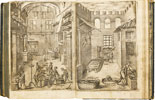


|
|

Antiquarian category
ref number:
11220
|



